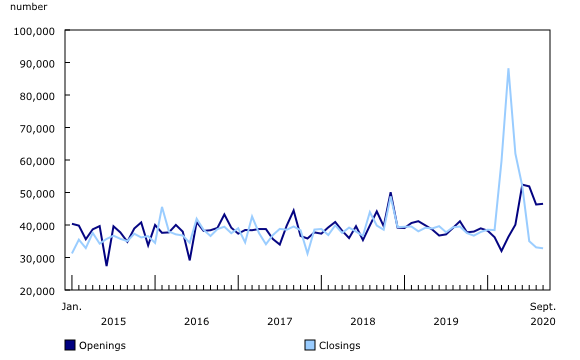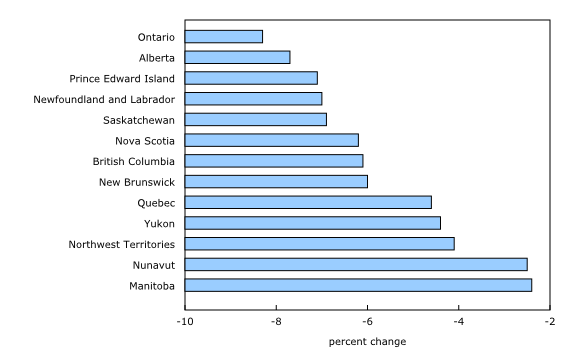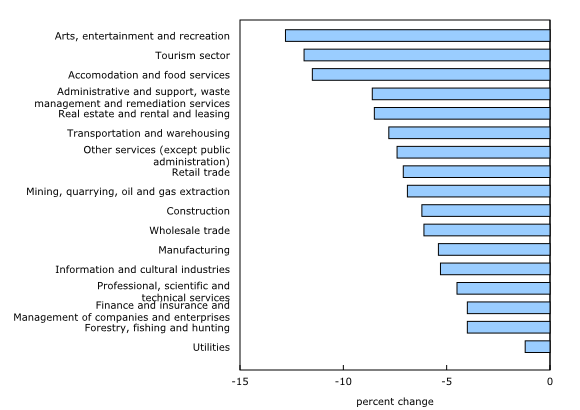Monthly estimates of business openings and closures, September 2020
Archived Content
Information identified as archived is provided for reference, research or recordkeeping purposes. It is not subject to the Government of Canada Web Standards and has not been altered or updated since it was archived. Please "contact us" to request a format other than those available.
Released: 2020-12-24
The September estimates of business openings and closures show that new business closures were largely unchanged since August. While some provinces, such as British Columbia and Ontario, implemented new guidelines for businesses in September, public health measures had been substantially eased throughout the country. In September, 32,830 business closures were observed in the Canadian business sector, 0.9% less than were observed in August. Similarly, the number of business openings remained steady in September, increasing by 0.5% since August to 46,517. As a result, the number of active businesses in September edged up slightly by 1.5%, yet remained 7.2% lower than in February 2020.
Additional public health measures were implemented in October and November to address the resurgence of the COVID-19 virus. The results in this release provide a snapshot of the situation in September and may not reflect the new measures. The series for October and November will be released in January and February 2021. As we head into the holiday season, which can represent a significant source of revenue for businesses, following the trends in business openings and closures will remain important.
With the exception of Prince Edward Island, which recorded an increase of 6.2% in business closures in September, declines in business closures continued to be observed in the Atlantic provinces. Notably, business closures in Newfoundland and Labrador, New Brunswick and Nova Scotia were at their lowest level since the beginning of the series in January 2015. In the rest of Canada, business closures remained relatively stable and lower than in February 2020.
Despite recent stability in business closures, in the largest province, the number of active businesses has yet to recover. In Ontario, there were 8.3% (or 25,614) less active businesses in September than in February. Alberta, Prince Edward Island and Newfoundland and Labrador experienced similar declines in active businesses, in percentage terms, from February to September.
In most industries, business closures showed little change from August to September. In some industries—including manufacturing, retail trade, and arts, entertainment and recreation—business closures reached a new low since the start of the series. Nevertheless, the number of active businesses remained lower than the pre-pandemic level in February 2020 across industries. In percentage terms, the number of active businesses in arts, entertainment and recreation was furthest from recovery in September, down 12.8% (or 1,855 businesses) since February. The tourism sector was second furthest and declined by 11.9% or 9,313; the majority (65%) of the decline in this sector occurred in food and beverage services.
In accommodation and food services, retail trade and other services (excluding public administration), which are among the most impacted industries in terms of business closures, the number of active businesses continued to be lower than the pre-pandemic level. It is anticipated that businesses in these industries and in the tourism sector will continue to face challenges in the coming months as restrictions are re-introduced.
Note to readers
Every new month of data leads to a revision of the released data due to such factors as the seasonal adjustment process and a new version of the Generic Statistical Universe File (or vintage of the Business Register). As such, the estimates may vary when compared to a previous release of the data.
Openings are defined as businesses with employment in the current month and no employment in the previous month, while closures are defined as businesses that had employment in the previous month, but no employment in the current month. Continuing businesses are those that have employees in both months, and the active population in any given month is the number of opening and continuing businesses in that month.
A business is defined as an enterprise operating in a particular geography and industry.
The vast majority of businesses operate in one industry and one location or geography. For these businesses, in the monthly estimates of openings and closings, they will be counted once at the national/provincial level. For example, a retailer in Windsor, Ontario will be counted as an active business in the Ontario estimates and once in the national estimates.
Some businesses can have multiple operations, and these can be in different industries and geographies. For such businesses, in the monthly estimates of openings and closings, they can be counted more than once because they are active in multiple industries or geographies. For example, if a retailer has operations in both Alberta and Ontario, it will be counted as an active business in both provinces, but only once at the national level because it represents only one active firm. Similarly, a firm with retail and wholesale operations will be counted in both industries when individual industries are examined. However, when the business sector is examined, the firm counts only once because at that level it represents one firm active in the business sector.
Contact information
For more information, contact us (toll-free 1-800-263-1136; 514-283-8300; STATCAN.infostats-infostats.STATCAN@canada.ca).
To enquire about the concepts, methods or data quality of this release, contact Amélie Lafrance, 343-572-3221; (amelie.lafrance@canada.ca), Economic Analysis Division.
- Date modified:




